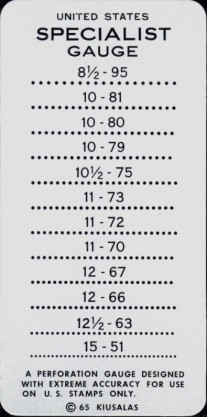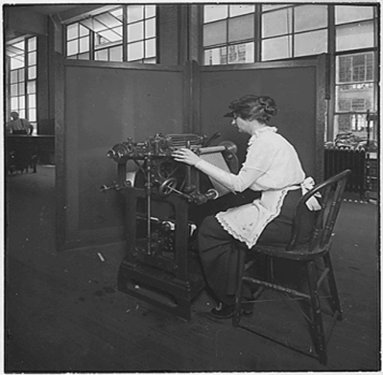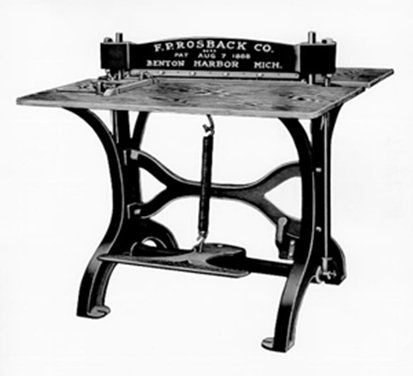U.S. Postage Stamp
Line Perforation Gauge Count Numbers
© 2017 Julian J. Goldberg
Updated - 07/28/2020
Line Perforating Machines (Perforators)

Kiusalas U.S. Specialized Perforation Gauge
Line Perforating Machines (Perforators) With Rotary Perforating Wheels

Bemrose Perforator and Rouletter

Howard Perforator
Center to center distance between perforations in inches |
Perforating pin width diameter size in inches |
Number of perforations per two centimeters |
Number of pins
or holes
on perforating wheels |
Perforating wheel size
diameter and circumference |
Reference |
0.051067” [Kiusalas 0.051"] |
0.042" |
8.27 |
134 |
(a) small perforating wheels with a 4 1/16″ (4.0625″) diameter and a 12.763″ (12 3/4″?) circumference (1910-1913) |
1, 2 |
0.0949” |
0.042" |
8.30 |
134 |
(b) small perforating wheels with a 4 3/64″ (4.046875″) diameter and a 12.714″ (12 5/7″?) circumference (1910-1913) |
2 |
0.0945” |
0.042" |
8.33 |
134 |
(c) small perforating wheels with a 4 1/32″ (4.03125″) diameter and a 12.665″ (12 2/3″?) circumference (1910-1913) |
2, 3 |
0.07975” |
0.042" |
9.87 |
160 |
(a) small perforating wheels with a 4 1/16″ (4.0625″) diameter and a 12.763″ (12 3/4″?) circumference [found together with long bar Kiusalas 80-9.84 and Kiusalas 81-9.72] (1921-1926) |
1, 2, 4 |
0.07946” |
0.042" |
9.91 |
160 |
(b) small perforating wheels with a 4 3/64″ (4.046875″) diameter and a 12.714″ (12 5/7″?) circumference (1913-1917) |
2, 7 |
0.07914” |
0.042" |
9.95 |
160 |
(c) small perforating wheels with a 4 1/32″ (4.03125″) diameter and a 12.665″ (12 2/3″?) circumference (1913-1917) |
2, 3, 5 |
0.07506” |
0.042" |
10.49 |
170 |
(a) small perforating wheels with a 4 1/16″ (4.0625″) diameter and a 12.763″ (12 3/4″?) circumference [found together with long bar Kiusalas 70-11.25 and Kiusalas 71-11.09] (1926-1939) |
1, 2, 4 |
0.075” |
0.042" |
10.50 |
415 |
(d) large perforating wheels with a 9 29/32″ (9.90625″) diameter and a 31.121″ (31 1/8″?) circumference [found together with long bar Kiusalas 70-11.25 and Kiusalas 71-11.09] (1939-1985) |
6 |
0.0729” |
0.042" |
10.80 |
175 |
(a) small perforating wheels with a 4 1/16″ (4.0625″) diameter and a 12.763″ (12 3/4″?) circumference (1920) [see Kiusalas 72.5-10.86 below] |
7 |
0.0725” |
0.042" |
10.86 |
176 |
(a) small perforating wheels with a 4 1/16″ (4.0625″) diameter and a 12.763″ (12 3/4″?) circumference [found together with long bar Kiusalas 80-9.84 and Kiusalas 81-9.72] (1915, 1917-1994) |
1, 2, 4, 7,
8 |
0.07225” |
0.042" |
10.90 |
176 |
(b) small perforating wheels with a 4 3/64″ (4.046875″) diameter and a 12.714″ (12 5/7″?) circumference (1915, 1917-1957) |
2 |
0.072” |
0.042" |
10.94 |
176 |
(c) small perforating wheels with a 4 1/32″ (4.03125″) diameter and a 12.665″ (12 2/3″?) circumference (1915, 1917-1957) |
1, 2, 3 |
0.06645” |
0.042" |
11.85 |
192 |
(a) small perforating wheels with a 4 1/16″ (4.0625″) diameter and a 12.763″ (12 3/4″?) circumference (1873-1914, 1943-1979) |
1, 2, 9 |
0.06645” |
0.042" |
11.85 |
576 |
(e) large perforating wheels with a 12 3/16″ (12.1875″) diameter and a 38.288″ (38 1/4″?) circumference [3 x (a) above] (1861-1873) |
2, 9 |
0.06625” |
0.042" |
11.89 |
192 |
(b) small perforating wheels with a 4 3/64″ (4.046875″) diameter and a 12.714″ (12 5/7″?) circumference (1910-1914) |
2 |
0.06595” |
0.042" |
11.94 |
192 |
(c) small perforating wheels with a 4 1/32″ (4.03125″) diameter and a 12.665″ (12 2/3″?) circumference (1873-1914, 1943-1979) |
2, 3, 9 |
0.06595” |
0.042" |
11.94 |
576 |
(f) large perforating wheels with a 12 3/32″ (12.09375″) diameter and a 37.994″ (38″?) circumference [3 x (c) above] (1861-1873) |
2, 9 |
0.06304” |
0.0345" |
12.49 |
500 |
(g) large perforating wheels with a 10 1/32″ (10.03125″) diameter and a 31.514″ (31 1/2″?) circumference (1919) |
10 |
0.06284” |
0.0345" |
12.53 |
500 |
(h) large perforating wheel
with a 10″ (10.00″) diameter and a 31.416″ (31 52/125″?) circumference (1919) |
10 |
0.05106” |
0.020" |
15.42 |
248 |
(c) small perforating wheels with a 4 1/32″ (4.03125″) diameter and a 12.665″ (12 2/3″?) circumference (1857-1861) |
2, 11 |

Kiusalas Gauge

Potter Printing Press Bar Perforator

Rosback (Stroke) Perforator
Rotary Perforating Bars
Perforators with rotary perforating bars were used to perforate web-fed Stickney and Huck-Cottrell rotary press printed coil stamps. Perforators with a combination of rotary perforating bars and rotary perforating wheels were used to perforate web-fed Stickney and Huck-Cottrell rotary press printed sheet and booklet stamps. Stamps perforated by rotary perforating bars mostly do have an exact alignment correspondence between perforations in different rows since they were perforated by several separate perforating bars mounted on the same one moving cylinder. The Bureau of Engraving and Printing (BEP) mostly used 0.042" diameter width size pins for its perforating bars unless otherwise noted differently below (References 1, 4).
Center to center distance between perforations in inches |
Perforating pin width diameter size |
Number of perforations per two centimeters |
Number of pins or
holes
on perforating bars |
Perforating bar size length
with pins or holes along it |
Reference |
0.095” |
0.042" |
8.29 |
91 |
(i) perforating bars with a short perforating length of 8 41/64″ (8.640625″) [1/2 x (l) below] (1910-1913) |
12 |
0.081” |
0.042" |
9.72 |
108 |
(j) perforating bars with a short perforating length of 8 3/4″ (8.75″) [1/2 x (k) below] (1915) | 8 |
0.081” |
0.042" |
9.72 |
216 |
(k) perforating bars with a long perforating length of 17 1/2″ (17.5″) [2 x (j) above] [found together with Kiusalas 72.5-10.86 and Kiusalas 79.75-9.87] (1921) | 8 |
0.080” |
0.042"-0.043" |
9.84 |
108 |
(i) perforating bars with a short perforating length of 8 41/64″ (8.640625″) [1/2 x (l) below] [large holes, (small holes)] (1914-1958) | 12 |
0.080” |
0.042" |
9.84 |
216 |
(l) perforating bars with a long perforating length of 17 9/32″ (17.28125″) [2 x (i) above] [found together with Kiusalas 72.5-10.86 and Kiusalas 79.75-9.87] [large holes] (1920-1926) |
4, 6 |
0.080” |
0.037" |
9.84 |
216 |
(m) perforating bars with a long perforating length of 17 9/32”(17.28125″) [2 x (i) above] [small holes] (1958-1985) |
13 |
0.071” |
0.042" |
11.09 |
247 |
(n) perforating bars with a long perforating length of 17 17/32″ (17.53125″) [found together with small wheel Kiusalas 75-10.50] (1926-1939) |
6 |
0.071” |
0.042" |
11.25 |
247 |
(l) perforating bars with a long perforating length of 17 9/32″ (17.28125″) [2 x (i) above] [found together with small and large wheel Kiusalas 75-10.50] (1926-1985) |
1, 4, 6 |
0.067” |
0.0395"-0.0415" |
11.75 |
125 |
(o) Rosback stroke perforator with one long length of 8 3/8″ (8.375″) with 125 pins or holes and three short lengths of 1 27/40″ (1.675″) with 25 pins or holes [U.S. patent 1,125,723 of 1915] (1914-1958) | 14 |
References
[1] Stamps, “Perforation Spacing on the 1908-19 Issue”, November 23, 1935, Page 310.
[2] The Collectors Club Philatelist, "Perforation Gauge 12 Used on U.S. Washington-Franklin (Third Bureau Issue) Stamps", Julian J. Goldberg, Volume 93, Number 6, Nov.-Dec. 2014, Page 368.
[3] The Philatelic Gazette, “Fake Perforations”, J.B. Leavy, May 1918, Page 154.
[4] The United States Specialist, “The Stickney Rotary 11 x 10-1/2 Bar and Wheel Perforator”, Louis E. Repeta, Whole Number 756, Volume 63, Number 4, April 1992, Page 168.
[5] The United States Postage Stamps Of The 20th Century 1901-1922, Volume 1 (Revised Edition), Max G. Johl, March 1937, H.L. Lindquist, Page 149.
[6] The Collectors Club Philatelist, “United States: Modern [1940s] Perforating Machines”, J.M. Kohler, July 1960, Pages 188, 207.
[7] The United States Specialist, “Perforation Measurement and Scott # 544”, Larry S. Weiss, Whole Number 680, Volume 57, Number 10, October 1986, Pages 448 to 449.
[8] The United States Specialist, “Specialist Gauge Measurements”, Larry S. Weiss, Whole Number 710, Volume 60, Number 4, April 1989, Pages 207 to 209.
[9] Early American Perforating Machines and Perforations 1857-1867, Winthrop S. Boggs, The Collectors Club Inc., September 1954, Pages 19 to 20, 27 to 28.
[10] The American Philatelist, “United States Stamps: APS Acquires Rosback Rotary Perforator”, Ken Lawrence, September 1995, Volume 109, Number 9, Pages 824 to 826.
[11] Early American Perforating Machines and Perforations 1857-1867, Winthrop S. Boggs, The Collectors Club, Inc., September 1954, Pages 2 to 10.
[12] U.S. Stamp News, “The Stickney Coil Perforator”, Louis E. Repeta, October 2007, Volume 13, Issue 10, Pages 16 to 17.
[13] Encyclopedia of United States Stamps and Stamp Collecting, Rodney A. Juell, Steven J. Rod, United States Stamp Society (USSS), 2006, Pages 511 to 512.
[14] The American Revenuer, “In Search of the Bureau Perforated Series of 1934 Red Bottle Stamps”, Ronald E. Lesher, November-December 2006, Volume 60, Number 6, Pages 173 to 175.





